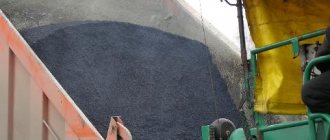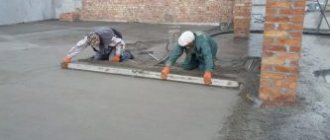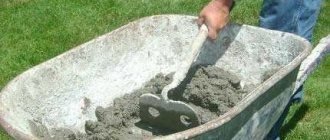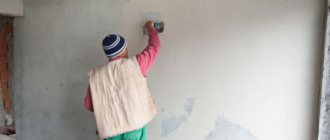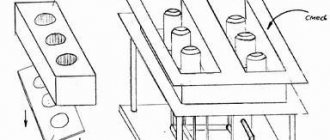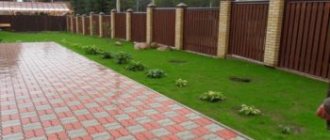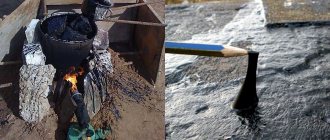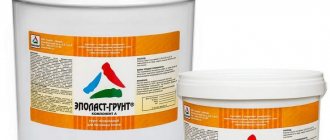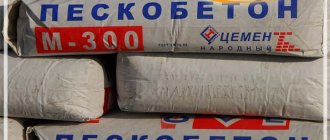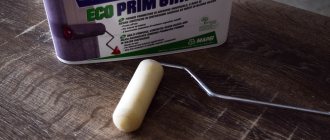Application of cement laitance in construction
Cement laitance is a liquid layer of concrete, the appearance of which stops the vibration of the solution. If it continues, delamination of the concrete mass may begin. Cement laitance, which forms naturally on the surface of a concrete product, has only disadvantages. If the mixture is prepared for certain types of work, it has many positive qualities. Cement laitance has the following advantages:
- strength;
- good sound insulation;
- water resistance;
- thermal insulation properties;
- the mixture hardens quickly.
There are no regulatory documents regarding the composition of cement laitance. The practice of using milk during construction work has shown that 3-4 times more water is consumed to prepare the mixture than cement. The prepared solution is used to repair cracks on the concrete surface. Many people ask the question: what is cement laitance?
Cement laitance is a mixture consisting of water and cement, having the consistency of sour cream. To give it a lighter shade, a certain amount of slaked lime can be added to the solution.
This mixture is used to strengthen and protect the external plastered surfaces of buildings from precipitation. Concrete is ironed with a solution of cement in water to give it additional strength. The solution is applied in a thin layer to the inner walls of metal barrels to protect them from corrosion.
Building houses is impossible without building a foundation. The foundation for a small private house can be constructed from slag or expanded clay. To do this, you need to dig a trench, assemble the formwork and pour granulated slag or expanded clay into it. After completing the work, you need to fill the contents with a solution of cement and water. The milk consists of 2 parts pure water and 1 part Portland cement. Expanded clay should be poured in such a way that a protective layer of cement laitance about 2 cm thick forms on top of the backfill.
Expanded clay is used for thermal insulation of ceilings and floors. This porous substance reduces the consumption of mortars. If the expanded clay layer is spilled with a mixture of cement and water, the granules stick together and the thermal insulation does not delaminate.
Before starting a concrete pumping line, the inside of the hoses is often treated with cement laitance. After treatment, they are not clogged with working mortars.
Cement laitance on the surface of concrete
The technical term “cement laitance” can mean not only a newly created “useful” building material widely used in construction. When laying and subsequent compaction of concrete mixture or cement mortar, the appearance of a gray liquid - cement laitance - is observed. After hardening, the concrete surface is covered with a thin crust 2 mm thick, which prevents further processing of the concrete surface.
Causes
There are several objective reasons that explain the formation of an unwanted liquid mixture on the surface of a concrete floor or cement-sand screed:
- Alkaline nature of cement. As is known, in terms of its chemical composition, cement belongs to the category of alkaline products. During mixing of a mortar or concrete mixture, a chemical reaction occurs with the formation of an aqueous solution of Ca(OH)₂. When the liquid reaches the surface of the laid concrete, calcium hydroxide comes into contact with a constituent of the air - carbon dioxide CO₂. A poorly soluble limestone layer of calcium carbonate (CaCO₃) appears on the concrete surface or floor screed.
- Incorrect proportions of cement and water. Of course, an increased amount of water when mixing concrete and cement building mixtures makes the solution more plastic and easier to install. During compaction and vibration, the mortar mixture separates into heavy and light components. Water with cement particles is displaced to the outer surface, and heavier components settle.
But even with a correctly composed water-cement ratio (WC) of concrete and mortar mixtures, cement laitance is released during compaction, only in small quantities.
Is it necessary to remove the laitance film?
The question of removing limescale from a concrete floor often worries beginners who are encountering this unpleasant phenomenon for the first time.
There are several reasons why it is necessary to remove laitance:
- To increase the adhesion of floor screed with finishing coating. If you apply varnish, paint or a polymer coating to a hardened layer of cement laitance, an intermediate layer of a brittle crust with weak strength is formed. Due to indirect contact with the body of the screed or concrete, the finishing coating will deform and collapse over time.
- Increasing the strength of a concrete floor or cement-sand screed. Under the influence of operational loads, concentrations of internal stresses arise in the floor structure. The remaining layer of hardened cement emulsion will be between the finish coat and the base of durable cement mortar or concrete. Since cement laitance is clearly inferior in strength to full-fledged cement mortars, it, as a “weak link,” will gradually deteriorate and the finishing coating will begin to crack.
Untimely removal of cement laitance can lead to a number of unpleasant problems:
- Complete or partial peeling of polymer finishing coatings;
- The appearance of sedimentary cracks - “cobwebs”, which leads to the gradual destruction of the applied decorative or polymer layer.
Under the influence of mechanical forces and due to temperature changes, the brittle surface film of hardened cement laitance is not able to “quench” the internal stresses that arise and therefore the outer surface of the concrete or screed begins to deform.
Why is it necessary to remove cement laitance from the surface of concrete structures?
When making concrete products, a layer of liquid consisting of cement and water often appears on their surface. This is cement laitance, which, when dried, forms a crust that prevents the surface from being treated with polymeric materials in the form of varnishes, paints and impregnations. The reason for the appearance of the crust is the presence of alkali in the cement, which forms calcium hydroxide with water. This chemical reacts with carbon dioxide from the air, resulting in the formation of calcium carbonate, more familiar to people as limestone. The crust is made of limestone.
Often this crust is undesirable and must be removed. The reason for removal is the strength, which is much lower than concrete. When the milk hardens, it acquires a glossy surface on which paint, varnish and other finishing compounds do not adhere well. Milk appears due to a violation of the ratio of components in the working solution. With a large amount of water, the solution becomes softer and more pliable, but its strength is also lost. Therefore, the solution must be made in accordance with the standards.
Removal
If laitance appears naturally, it must be removed from the surface. To remove unwanted film, you can use one of the following methods:
- Mechanical method. This involves the use of sandblasting or crushing machines. This removal technique is quite expensive and difficult to perform. However, the use of special equipment will allow you to remove cement laitance even from hard-to-reach places. Mechanical cleaning can be carried out using ordinary metal brushes, but in this situation it will take a lot of time, since each area will have to be manually processed.
- Dry cleaning, which involves the use of special solutions containing acid. With their help, you can remove unwanted film as quickly as possible. However, the negative side of this method is that the product, while removing plaque, has a negative effect on the concrete itself. You should resort to this method only when mechanical cleaning has proven ineffective.
The chemical composition used to remove cement laitance can be neutralized using concentrated alkali. After carrying out these procedures, the surface must be rinsed thoroughly.
What is cement laitance, see the video below.
How to remove cement laitance?
The liquid layer of milk from the surface is removed by grouting. Solidified milk is scraped off or removed by other means. The cement laitance composition is removed from the concrete surface in two ways:
- mechanically;
- chemically.
The most common is the mechanical method. The most common method used is to grind the surface using a grinding machine. On small surfaces, it is enough to have a manual machine in the form of a grinder with a special diamond cup. It is difficult to work with it, since at high speeds there is no dust collector, personal protective equipment is required. This tool is difficult to keep on the surface.
An effective, but expensive mechanical method is to process the milk layer with a shot blasting or sandblasting machine to a depth of up to 2 mm. Both devices are heavy and bulky, so they are used only in production enterprises. All mechanical methods of removing milk require a lot of labor and expensive equipment. Their disadvantage is the inability to process the product in hard-to-reach places.
The chemical method includes treating the surface with solutions of various acids: acetic, hydrochloric and others that react with milk. The chemical method is effective, but has a negative side: along with the removal of the milk layer, it has a negative effect on the concrete. Therefore, after chemical treatment, the surfaces are neutralized with concentrated alkali and washed with a strong stream of clean water to wash away all acid residues.
Several ways to remove unwanted laitance
You can remove cement laitance from a concrete floor in the following ways:
- Sanding the finished surface. The cement film of large area concrete floors is removed using mosaic grinding machines. In small areas, it is advisable to use hand-held grinders or an angular disc power tool “grinder” with a diamond attachment.
- Sandblasting with quartz sand. This method is considered the most effective, but due to the availability of special equipment, it is used extremely rarely.
- Chemical treatment. This method is based on treating the top layer of concrete with a solution of low concentration hydrochloric or acetic acid. A chemical reaction begins on the surface of the concrete floor to neutralize limescale. The decomposition products are washed off abundantly with water, and the surface is completely cleared of the hardened cement crust.
In small apartments or private houses, a simpler method of cleaning with metal brushes or brooms with wire bristles is used to remove the carbonized layer.
How to prepare cement laitance? What is it used for?
Cement laitance dries and hardens quickly, serves as waterproofing, retains heat and does not allow sound to pass through. It is prepared for:
- filling cracks and chips in concrete or cement;
- pouring expanded clay with cement laitance;
- surface leveling;
- improving the strength of the plaster layer;
- protecting wall surfaces from snow and rain;
- ironing of concrete surfaces;
- protection of metal surfaces from corrosion;
- processing the inner walls of concrete mixer hoses.
In all of these cases, milk is prepared specially from cement powder and water. Sometimes slaked lime or a primer is added to the solution to increase its plasticity. How to make cement laitance for pouring surfaces. The three most commonly used formulations are:
For suspension, ratio of components:
- Portland cement – 1 part;
- water – 2 parts.
In the liquid dough, the ratio is 1.5: 1, in the suspension - 1: 1.
The cement is sifted, freed from debris and lumps, and mixed with a construction mixer or drill with an attachment.
The technology for pouring expanded clay requires preparing milk in the form of a suspension. The composition is prepared as follows:
- sifted cement is dissolved in water to the consistency of sour cream;
- the composition is mixed with a mixer and the remaining water is gradually added to it;
- the solution is mixed until a homogeneous fluid mass is achieved.
To check the quality of the prepared mixture, it is recommended to perform the following steps:
- spill a small area;
- wait about 20 minutes;
- rate the quality.
If after 20 minutes the solution penetrates downwards and leaves no traces on the surface, the cement laitance is too liquid. Portland cement or lime should be added to the solution. If a lot of solution remains on the surface, you need to add water to it. The best option is that the main part of the milk has seeped through the expanded clay, leaving a layer about 2 cm thick on the surface. If the expanded clay layer is spilled with such a mixture, it will acquire the necessary strength.
To eliminate cracks and cracks, the solution is prepared slightly differently:
- take 2 parts of cement;
- 1 part water.
To make a cement screed, add the following to the milk:
When constructing a foundation, a sand cushion is placed underneath it. You can additionally spill the sand with a 1:1 suspension solution. If the milk is being prepared for finishing work indoors, you need to add 3 parts of sifted cement to 1 part water.
Consumption and price of cement laitance
Cement laitance is prepared from water and Portland cement in different ratios, so its cost differs. The solution is consumed in different quantities. The largest amount of solution is needed for pouring expanded clay; much less mixture is consumed to seal cracks.
Calculating the cost per cubic meter of solution looks like this:
- cement - water in a ratio of 1: 3 - 2800-3000 rubles;
- with a cement to water ratio of 1:2 – 3000-3500 rubles;
- the cost of a 1:1 suspension is 4500 rubles;
- cement to water ratio 2:1 – more than 5,000 rubles.
It is not always necessary to prepare milk in cubic meters; it is made in quantities necessary to complete the intended work. The composition dries quickly and a large amount of it is wasted money. After a few hours it will dry out or the cement will settle to the bottom of the container.
After this, it is impossible to give the solution a homogeneous state. For an expanded clay layer, filling is required in larger quantities than when covering cracks. The consumption of cement laitance for pouring m³ of foundation should be sufficient to wet the material, but not to flood the structure.
When pouring floors, a special trowel or lath is often used. In this case, you need to take half as much cement, its consumption per 1 m is reduced, and the mixture loses its weight. Water is required 2-3 times more than cement. After pouring expanded clay with such a solution, the layer becomes durable and you can walk on it. Complete drying occurs within a day. After this, you can lay the decorative coating.
To finish the walls inside and outside the building, a solution is used in a ratio of 1:3. It carefully processes every m² of area, making the surface more resistant to precipitation. When preparing cement laitance and when working with it, you must use a respirator and safety glasses. The solution should be washed off if it comes into contact with the skin.
What it is?
Sand-cement mortar is mixed from three components: cement powder, sand and water. This composition, in the case of the correct ratio of all its parts, is a homogeneous mass. However, after laying the cement and compacting it, a watery film of cloudy white or gray color often appears on the surface. This white substance is the so-called laitance. In appearance it resembles liquid glass, especially in the first stages of solidification.
This watery mass is formed as a result of the fact that when the laid mortar is compacted, it separates. Often this process can occur if the cement mixture was prepared with the addition of insufficient water, and the finished solution turned out to be too dry. In this case, water and individual cement particles are displaced to the surface from the internal layers, forming a liquid film. Another reason for the formation of a liquid surface layer can be a chemical reaction inside the sand-cement mass. It is associated with the influence of alkali metals.
Concepts. Definition. Composition and proportions
There are two concepts of cement laitance:
- Cement laitance is a water-cement mixture that is diluted to a liquid state, without the use of sand or aggregate. There are no exact proportions for preparing such cement mixtures; they are selected for each specific situation.
- When constructing a reinforced concrete structure by vibration, a little liquid is released, this is cement laitance. After it is isolated, it is necessary to stop vibrating so that the solution does not separate.
The basis for the formation of milk can be an aqueous solution of calcium hydroxide, which, after laying the coating, comes to the surface and, in reaction with carbon dioxide, is converted into a water-insoluble film of calcium carbonate.
It can also be formed from alkali metal salts that are found in concrete; waste ash from power plants or other admixtures added to concrete. When creating a water-cement solution, the alkali interacts with other substances in the mixture and, when exposed to air (under the influence of CO2), carbonizes. Another reason for the formation of a film may be the incorrect use of mixing water in the solution.
The film interferes with the adhesion of the concrete base and finishing materials. The milk must be removed, otherwise it will peel off on its own and fall off along with the paint. Instead of a monolith, three layers of material are obtained, which reduces the expected strength by half. Each layer takes the load separately, and not as a single unit.
If too much liquid is released, this means that the water-cement balance or the number of components has been disturbed.
Return to contents
Application
Still, cement laitance is not a completely useless mass. In addition to its negative and undesirable function, this composition can be used for a number of construction works.
Laitance of cement is specially prepared and used for the following purposes:
- filling small cracks in a concrete or cement layer, sealing chips;
- the composition serves as a pouring agent for expanded clay particles in the heat-insulating layer of the screed;
- leveling various surfaces;
- strengthening the plaster layer;
- securing and protecting surfaces from exposure to precipitation;
- ironing of bases;
- protection against corrosion of metal surfaces and containers;
- pre-treatment of hoses for concrete pumping and mortar pumping units before the first start-up. The composition envelops the walls of the hoses and prevents solutions from sticking to them, which reduces the likelihood of clogging and clogging.
Preparing the mixture
Depending on the purpose and use, the water-cement mixture can be prepared in different ratios of its constituent parts. There are three main types of compositions, differing in the proportion of components included in the mixture - Portland cement and water: suspension (1: 2), batter (1.5: 1), suspension (1: 1).
Before starting to mix the solution, it is recommended to sift the cement. The presence of lumps or debris will prevent the mixture from becoming homogeneous. To mix the water-cement solution, use a drill with a special attachment or a construction mixer.
The following solution preparation technology is used in case it is necessary to spill the expanded clay layer:
- The mixture proportion required for this type of work is 1 part Portland cement and 2 parts water. First, the cement is dissolved with a small amount of water until it becomes thick like sour cream;
- Then, with constant intensive stirring, the remaining water is added in small portions. The solution should become fluid;
- Stirring continues until a completely homogeneous liquid mass is obtained.
If the composition will be used to seal cracks in concrete, it will be made thicker. The proportions of cement and water are 2: 1. To strengthen a concrete or cement screed, the cement laitance should contain about 30% Portland cement. To lay the underlying layer under the foundation, cement powder and water are mixed in equal proportions. If the composition is used for interior decoration, 3 parts of Portland cement and 1 part of water are added to the solution.
Cost calculation
The cost of the mixture per 1 m², as well as the weight of one liter of the mixture, will vary depending on the type of composition itself and the type of work. Typically, pouring expanded clay requires the highest consumption of water-cement mortar.
An approximate calculation of the cost of a solution from the ratio of its components is as follows:
- with a ratio of 1 part cement to three parts water, the price in the estimate will be approximately 2800–3000 rubles per 1 m³;
- if 1.5 or 2 parts of water are taken for 1 part of Portland cement, then the cost of a cubic meter will increase to 3000–3500 rubles;
- for a solution with an equal ratio of constituent components, the price will increase to 4,500 rubles per 1 m³ of the finished mixture;
- if to prepare the solution it is necessary to spend 2 parts of cement to 1 part of water, then the cost of a cube of finished cement laitance will exceed 5,000 rubles.
Proportions and preparation of cement laitance
Every novice builder is faced with such a concept as cement laitance (CM). This name sounds quite harmless, but many experts strongly recommend removing the mass that has formed on the concrete surface. On the other hand, there are a lot of recommendations according to which CM allows improving the characteristics of not only concrete, but also crushed stone, as well as expanded clay. Let's understand all the intricacies of using this liquid.
Why do you need to remove cement laitance?
First of all, you need to understand what cement laitance is.
To pour concrete, a solution is prepared from Portland cement, sand and water. If all components are selected in the correct proportion and were mixed until a homogeneous mass is obtained, then the composition is considered optimal. However, quite often the mixtures are prepared too dry, which is why the concrete mass begins to delaminate during laying and vibration compaction. Heavier components displace water and cement outward, and a dirty white suspension is formed on the surface, which is called a cement film or milk.
Healthy! Sometimes CM is formed as a result of chemical reactions occurring in the concrete mass (under the influence of alkali metals). In addition, ash and other wastes are often added to concrete, which also lead to the formation of a milky film.
Most often, the appearance of CM is an undesirable effect, since such a film has very low strength characteristics and a glossy texture. Because of this, the adhesion of the top layer of the concrete surface is reduced. If you paint such a screed, then after a few years the finishing layer will begin to fall off. This happens because the CM prevents the paint from penetrating the sand-cement mass.
Laitance of cement - what is it?
As a rule, inexpensive Portland cement and water are used to mix the composition. Proportions are determined depending on the type of application. The ease of preparation allows you to make it yourself. On the scale of large-scale construction, when constructing reinforced concrete structures using the vibration method, a water-cement mixture is also released. This is a signal to stop vibration, otherwise the solution may separate. Being a production waste, cement lait is a water-insoluble deposit of calcium carbonate salt. It is formed due to the chemical reaction of calcium hydroxide, which is released on the surface of the stone, with carbon dioxide from the air.
The formation of a large amount of liquid indicates a violation of the ratio of water and cement in concrete.
Why remove laitance?
In the case of concrete pouring work, finishing stages are assumed in the future. More often this is the application of another coating, for example, painting. The whitish solution creates an intermediate layer between the hard surface and the paint, preventing it from being absorbed deeply into the stone. In addition, the strength of the structure is reduced due to delamination of the monolith. Over time, the water-cement mixture will begin to peel off on its own along with the paint layer. This is low-quality work that does not guarantee the durability of the coating. Therefore, the milk film must be removed before the mass completely hardens. If the concrete does dry out, it begins to shine like gloss.
Removal methods
The use of any method must be justified specifically in each situation. The table shows the main methods for removing milk:
The latter method is rarely used, since chemical reagents not only remove the white suspension, but also negatively affect the properties of the artificial stone. After using the acid, it is recommended to treat it with a concentrated alkaline solution until complete neutralization. Compliance with safety precautions is important. Afterwards, rinse the surface thoroughly with water.
How to remove CM
To do this, you can use one of the methods for removing unwanted film:
- Mechanical. In this case, the film formed on the surface is removed using shot or sandblasting machines. This technology is considered expensive and very labor-intensive. In addition, it is difficult to remove milk from hard-to-reach places using machines. In this case, it is most convenient and cheaper to use water-air equipment. Also, mechanical cleaning can be done using ordinary metal brushes, but this will take a lot of time.
- Chemical. In this case, special acid solutions based on hydrochloric or acetic acid are used to remove CM, which allow you to get rid of unwanted plaque in the shortest possible time. However, it is worth considering that such compositions not only dissolve the film, but also negatively affect the concrete itself. This method is used extremely rarely.
Healthy! When chemically removing a film with a solution of hydrochloric acid, it is necessary to neutralize the composition using concentrated alkali. After applying the solution, the surface is thoroughly washed.
Despite all the disadvantages of CM, such compositions are quite often used for certain types of work.
Methods for removing film from the surface of concrete
- Mechanical method. Sandblasting or crushing machines are most often used here. The advantage is the ability to remove released milk from hard-to-reach places. The downside is the high cost of the equipment and difficulty in operation.
- Manually. Here it is suggested to use metal brushes. This is not at all expensive, but it will require a lot of effort and time, because each section will have to be brushed manually.
Dry cleaning. The only plus is the record-breaking short time during which you can quickly get rid of cement laitance. When dry cleaning, special solutions containing acid, such as hydrochloric or acetic acid, are used. They affect not only the unwanted film released after laying concrete, but also the “body” of the cement itself. This cleaning method should be chosen when other methods have not given the desired effect. To neutralize the plaque removal solution, you can use concentrated lye. After completing the procedures, the surface to be treated is thoroughly washed.
Application of CM in construction
Depending on the type of base, the milk is used for:
- sealing small cracks in the base;
- pouring expanded clay when installing a heat-insulating layer of screed;
- ironing of bases;
- strengthening the underlying layers (sand and cement) during the construction of foundations;
- repair of old concrete (sealing cracks and chips);
- processing of metal containers (thanks to CM, corrosion protection increases);
- leveling surfaces.
Depending on the scope of use of the solution, the milk is prepared in different proportions.
Application area
The solution in question can be used for:
- eliminating small cracks and chips in the base;
- pouring a layer of expanded clay, which makes it possible to impart heat-insulating properties to the coating;
- to strengthen the underlying layers when creating the foundation;
- repairing various damage that occurs in old concrete;
- processing metal containers, since milk increases anti-corrosion properties;
- to level the surface.
In addition, cement laitance can be used in other situations:
- used to secure bedding under the beam covering;
- allows you to reduce the porosity of various surfaces;
- can be used as a process fluid when using concrete pumps, etc.
Milk consumption per 1 m2 of cultivated area is directly related to the purpose of its use. The cost of 1 m3 depends on the proportions of the components included.
How to prepare CM
Compositions of this type are not controlled by building codes, since it all depends on the specific situation. Therefore, there are several recipes for preparing such a mixture:
- To seal cracks, a solution of water and cement is prepared in a ratio of 2:1.
- When strengthening the screed, the proportion of cement should be up to 30% of the total mass.
- When laying the underlying layer under the foundation, the components are mixed in equal parts.
- To impregnate expanded clay with cement mortar, it is recommended to prepare a more liquid solution - add 2-3 parts of water to 1 part of PC.
- When finishing interior or exterior walls, you need to mix 3 parts of cement and 1 part of water.
Thus, CM can be in the form of a suspension, liquid dough or suspension. Based on this, the composition is rubbed into the concrete during the process of hardening or poured onto the aggregate (for example, an expanded clay layer). If laying will be done manually, then it is more convenient to prepare a thicker mass from PC and water (3:1). If you plan to use a special grater or lath, then it is better to reduce the amount of cement to 1.5 shares.
Before preparing the solution, it is necessary to sift the Portland cement so that there are no lumps or debris left in it. To ensure that there are no clots in the finished milk, it is recommended to use a drill with a mixer attachment to mix the components. To increase the plasticity of the CM solution and achieve a lighter shade of the solution, it is recommended to add slaked lime to it.
If, when laying and filling a layer of expanded clay with cement-sand mortar, the CM is not poured, then the smallest granules of the material will begin to rise to the top, and the heavier ones will sink down. This will significantly affect the strength and density of the entire structure. To prevent such delamination, the expanded clay must be soaked in milk so that each granule is covered with a liquid solution. This will lead to gluing of the material, which will be a homogeneous, durable mass.
The consumption of CM in this case will depend on the thickness of the layer.
Cooking technology
The process of preparing the milk in question is quite simple. Based on the expected volume of work, you need to calculate and measure the required amount of cement. Remember that the amount of water should be 2-3 times more than cement powder. Then you need to do the following:
- Add a little water to the cement, stirring the mixture thoroughly and bringing it to a homogeneous state.
- Without forgetting to stir, you need to gradually add water to make the solution more fluid.
- If for some reason you do not have the required amount of cement, then slaked lime can save the situation. It can replace a small part of cement powder.
In some cases, a primer is used to create milk, which acts as an additional component. To prevent lumps from appearing during the preparation process, it is worth passing the cement through a fine sieve. This way, there will be no lumps or debris left in the powder.
As noted earlier, the composition of cement laitance is not controlled by regulatory documents, so everything depends on the specific situation.
There are several common recipes for preparing the mixture in question.
- If you need to seal cracks with mortar, then cement and water must be mixed in a 1:2 ratio.
- To strengthen the screed, the amount of cement should be no more than 1/3 of the total amount of the mixture. The weight of one liter should not be too large.
- Equal proportions are required in order to lay the underlying layer under the foundation.
- To fill expanded clay, the mixture should have a more liquid appearance. Therefore, water is needed 3 times more than the amount of cement.
- If you are finishing the walls, then mix water and cement in a ratio of 1: 3, and it does not matter whether the finishing will be done inside or outside the room.
Based on the possible mixing options, cement laitance can be presented in various variations in consistency. It can be in the form of a suspension or look like a batter. You can also find the mixture in the form of a suspension.
For thorough mixing, it is recommended to use a drill with a special attachment, otherwise there may be clots in the finished milk. You can increase the plasticity of the prepared mixture by adding slaked lime, which was already mentioned earlier. The consistency of the pour should be like liquid glass.
To obtain cement laitance of optimal consistency, it is important to use three times more water than for preparing the mixture for screed. To achieve the desired effect from using the solution, it is necessary to achieve optimal density.
To check this parameter of the material in question, perform the following steps.
- We pour a small part of the space covered with expanded clay.
- We wait 20 minutes.
- We monitor the results of the test.
- If the solution has completely penetrated downwards and there are no traces on the surface, then the milk has turned out to be excessively liquid.
- If almost all of the solution or most of it remains on the surface, then in this case it is necessary to add more water.
- The best option is one in which most of the liquid will seep through the cushion, but a small amount of cement laitance will remain on top
Consumption and cost of cement laitance
Since in nature there are no GOST standards regulating the ratio of components and consistency of milk, its consumption per 1 m 2 will differ depending on the purpose of using the composition. However, processing expanded clay usually requires a little more composition than when ironing concrete.
In turn, the cost of the solution also directly depends on the ratio of components in the CM:
- If the composition contains 1 part of cement and 3 parts of water, then it will cost about 2,800 rubles per 1 m 3.
- If the ratio of cement and water is 1:2, you will have to pay about 3,000 rubles.
- If 1 part of PC requires 1.5 parts of water, then such a solution will cost about 3,500 rubles.
- With an equal ratio of components, you will have to pay 4,500 rubles per cube of milk.
- If the volume of cement is 2 times the water content, then the price of the mixture increases to 5,500 rubles.
Of course, it is much more profitable to make the solution yourself.
Peculiarities
You've probably noticed that after using cement mortar, a film forms on the surface of the concrete, which is visually similar to gray water. This is exactly what cement laitance is. This liquid negatively affects the strength of the finished coating, so it must be removed immediately. After drying, a crust will appear on the concrete, which will negatively affect the adhesion of the concrete base to other coatings.
If you do not remove the cement laitance and immediately start painting, then be sure that your work will last no more than a year. Soon the paint will begin to crumble and peel. This is due to the fact that cement laitance prevents the paint from penetrating deep into the concrete, which is why, no matter what topcoat you choose, it will last a relatively short time.
However, cement laitance also has significant positive characteristics. The solution in question is often used to create floors, attic floors and roofs, which are insulated using expanded clay. This material consists of many granules that differ in size and weight. Based on this, some granules that find themselves in a liquid medium try to rise to the surface, and the strength of the backfill decreases.
Expanded clay gravel, which has been laid and leveled, should be covered with a layer of cement laitance a couple of centimeters thick. This layer is necessary for the implementation of protective functions, and it also acts as a reliable base for other coatings. It is important to note that cement laitance penetrates deep into the backfill, affecting even lighter expanded clay granules.
In order for the backfilled layer to acquire a structural shape, you will need to mix one part of cement and 2 parts of water. You can make a similar solution yourself. This mixture penetrates perfectly through the backfill, treating all expanded clay granules and enveloping them with a film of binder. After the cement laitance has dried well, the expanded clay layer will acquire additional cohesiveness. This backfill is now suitable for screeding.
